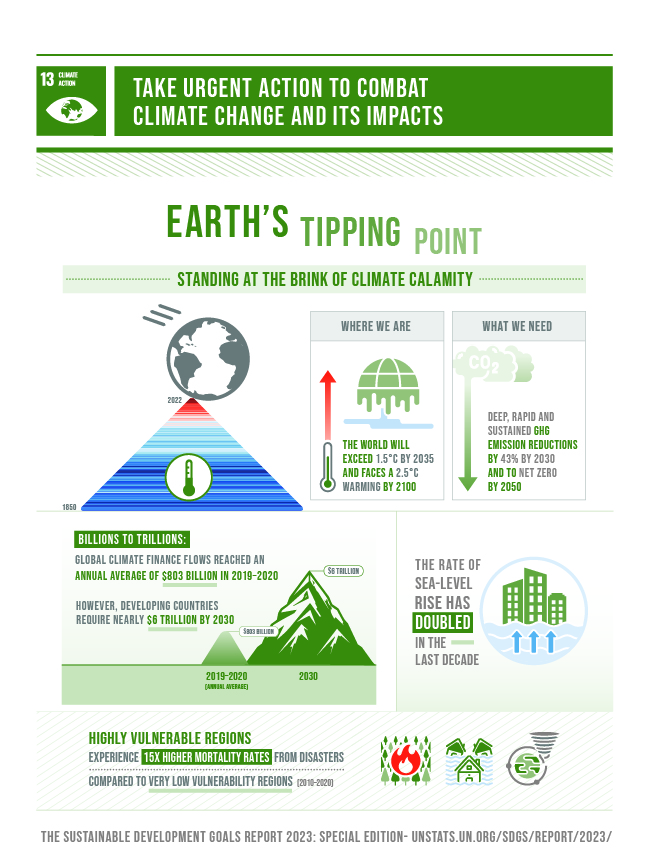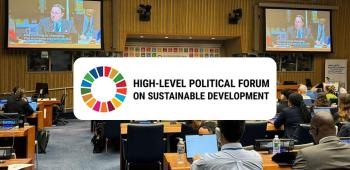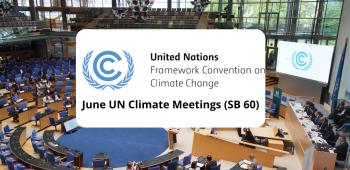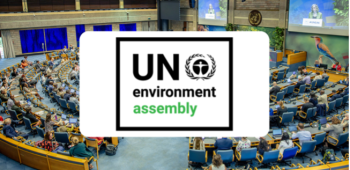Overview
Targets and Indicators
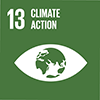
13.1
Strengthen resilience and adaptive capacity to climate-related hazards and natural disasters in all countries
13.1.1
Number of deaths, missing persons and directly affected persons attributed to disasters per 100,000 population
13.1.2
Number of countries that adopt and implement national disaster risk reduction strategies in line with the Sendai Framework for Disaster Risk Reduction 2015–2030
13.1.3
Proportion of local governments that adopt and implement local disaster risk reduction strategies in line with national disaster risk reduction strategies

13.2
Integrate climate change measures into national policies, strategies and planning
13.2.1
Number of countries with nationally determined contributions, long-term strategies, national adaptation plans and adaptation communications, as reported to the secretariat of the United Nations Framework Convention on Climate Change
13.2.2
Total greenhouse gas emissions per year

13.3
Improve education, awareness-raising and human and institutional capacity on climate change mitigation, adaptation, impact reduction and early warning
13.3.1
Extent to which (i) global citizenship education and (ii) education for sustainable development are mainstreamed in (a) national education policies; (b) curricula; (c) teacher education; and (d) student assessment

13.a
Implement the commitment undertaken by developed-country parties to the United Nations Framework Convention on Climate Change to a goal of mobilizing jointly $100 billion annually by 2020 from all sources to address the needs of developing countries in the context of meaningful mitigation actions and transparency on implementation and fully operationalize the Green Climate Fund through its capitalization as soon as possible
13.a.1
Amounts provided and mobilized in United States dollars per year in relation to the continued existing collective mobilization goal of the $100 billion commitment through to 2025

13.b
Promote mechanisms for raising capacity for effective climate change-related planning and management in least developed countries and small island developing States, including focusing on women, youth and local and marginalized communities
13.b.1
Number of least developed countries and small island developing States with nationally determined contributions, long-term strategies, national adaptation plans and adaptation communications, as reported to the secretariat of the United Nations Framework Convention on Climate Change
Progress and Info
Human-induced climate change reached alarming new levels in 2024, with some impacts already irreversible for centuries. Global temperatures broke records and temporarily exceeded the 1.5°C threshold, highlighting the urgent need to curb greenhouse gas emissions. Extreme weather events – including tropical cyclones, floods and droughts – led to the highest number of new displacements in 16 years, worsening food crises and bringing massive economic losses and social instability. Nonetheless, with bold action, limiting long-term global warming to 1.5°C is still possible. Every fraction of a degree matters in reducing risks, lowering costs and preventing catastrophic and irreversible damage to people and the planet. At the twenty-ninth session of the Conference of the Parties to the United Nations Framework Convention on Climate Change, States set a new collective quantified goal on climate finance and completed guidance to fully operationalize article 6 of the Paris Agreement on carbon markets, along with making additional commitments on mitigation, adaptation and the operationalization of the Fund for Responding to Loss and Damage.
Target 13.1 - Disaster-related deaths and missing persons dropped from 1.61 per 100,000 population in the period 2005–2014 to 0.79 in the period 2014–2023. Nonetheless, disasters claimed 41,647 lives annually over the past decade. The number of people affected by disasters surged by more than two thirds, from 1,158 per 100,000 population in the period 2005–2014 to 2,028 in the period 2014–2023, with an average of 124 million people affected every year over the past decade. 114.
By 2024, 131 countries reported the adoption and implementation of national disaster risk reduction strategies, up from 57 in 2015.
Target 13.2 - 2024 likely marked the first year when global temperatures surpassed the 1.5°C threshold, reaching 1.55°C above the pre-industrial level – making it the hottest year in 175 years. This was driven by rising greenhouse gas emissions, El Niño and other factors. In 2023, atmospheric concentrations of CO₂ levels remained at their highest in more than 2 million years and were 151 per cent above pre-industrial levels.
Target 13.a - According to the Standing Committee on Finance of the United Nations Framework Convention on Climate Change, global climate finance flows reached an annual average of $1.3 trillion in the biennium 2021–2022, a 63 per cent increase from 2019 to 2020, driven by higher investment in key mitigation sectors. Sustainable transport saw the largest rise (96 per cent), followed by clean energy (53 per cent) and buildings and infrastructure (41 per cent). Tracked adaptation finance also rose by 28 per cent to $63 billion annually, mainly through commitments from development finance institutions.






